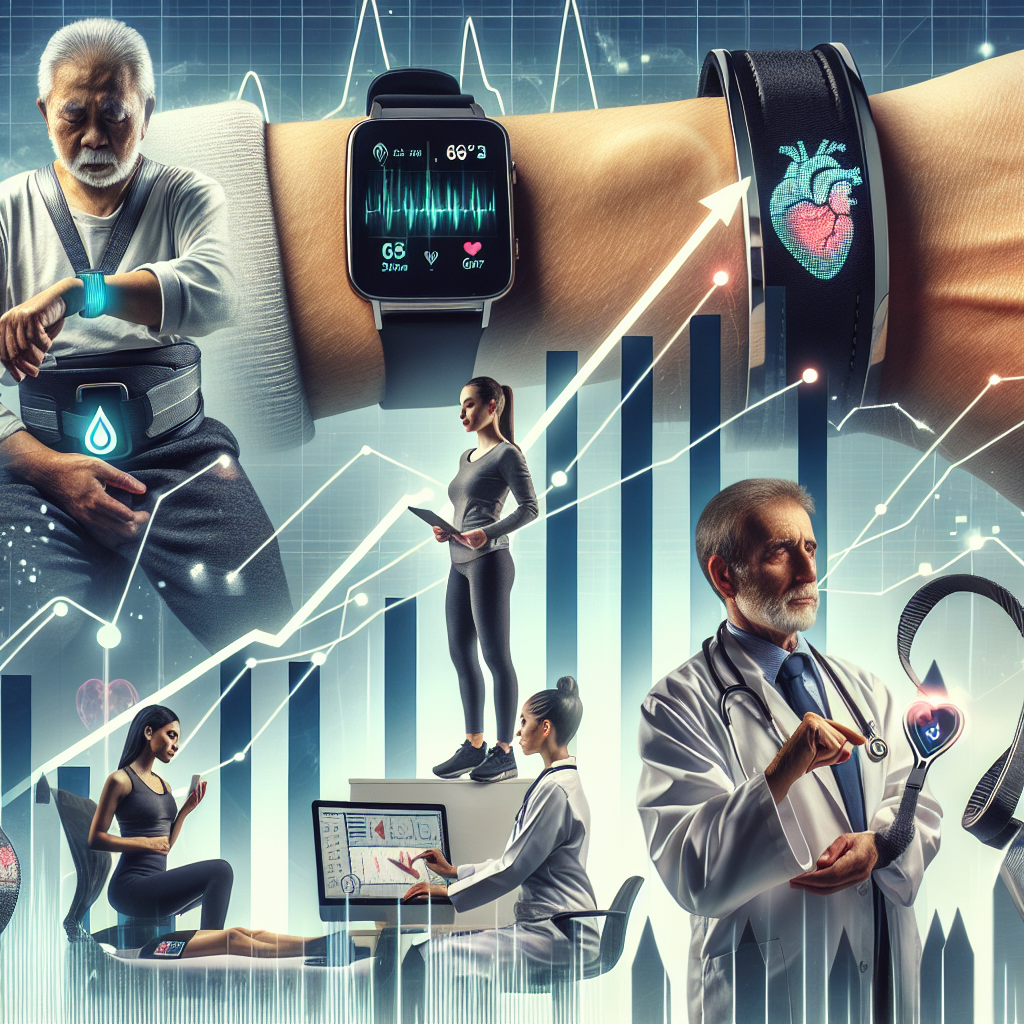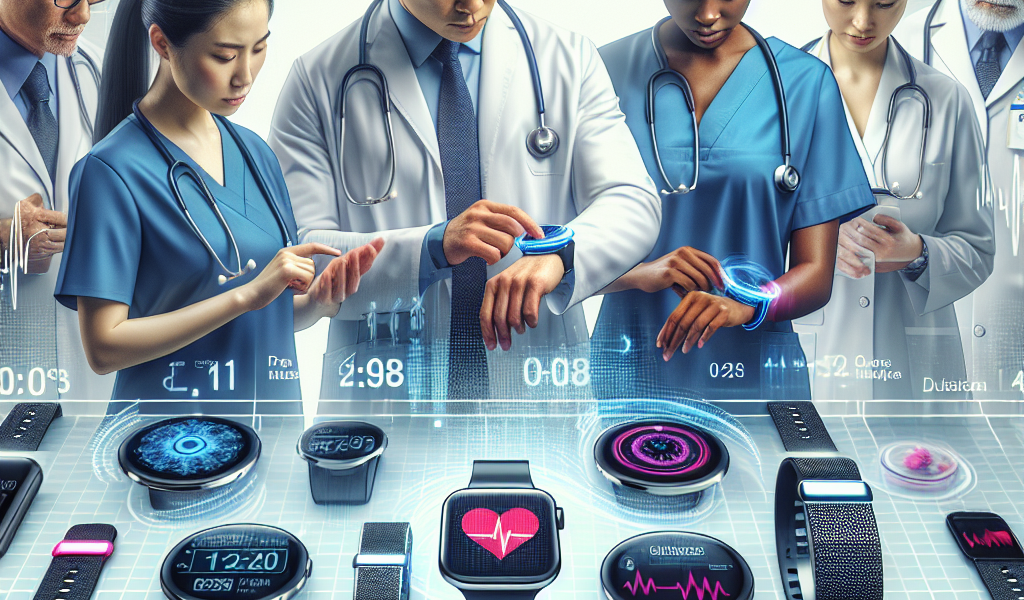-
Table of Contents
“Empowering Health: The Future of Care on Your Wrist”
Introduction

The Rise of Wearable Technology in Healthcare
The advent of wearable technology has revolutionized the healthcare industry, offering unprecedented opportunities for continuous health monitoring, personalized medicine, and proactive disease management. These innovative devices, ranging from smartwatches and fitness trackers to advanced biosensors and smart clothing, enable real-time data collection and analysis, empowering both patients and healthcare providers with actionable insights. By seamlessly integrating into daily life, wearable technology not only enhances patient engagement and adherence to treatment plans but also facilitates early detection of potential health issues, ultimately improving outcomes and reducing healthcare costs. As the technology continues to evolve, its potential to transform healthcare delivery and promote a more preventive, patient-centered approach becomes increasingly evident.
The Evolution Of Wearable Health Devices
The evolution of wearable health devices has been nothing short of revolutionary, transforming the landscape of healthcare in ways previously unimaginable. Initially, wearable technology was limited to simple fitness trackers that counted steps and monitored basic physical activity. However, as technology has advanced, so too has the sophistication and functionality of these devices. Today, wearable health devices encompass a wide range of applications, from monitoring chronic conditions to providing real-time health data to both users and healthcare providers.
One of the most significant advancements in wearable health technology is the integration of sophisticated sensors capable of tracking a variety of physiological parameters. Modern devices can monitor heart rate, blood pressure, oxygen saturation, and even electrocardiograms (ECGs). This wealth of data provides users with a comprehensive overview of their health status, enabling them to make informed decisions about their lifestyle and medical care. Moreover, the ability to continuously monitor these parameters offers a level of insight that traditional, periodic check-ups simply cannot match.
In addition to personal health monitoring, wearable devices have found a crucial role in managing chronic diseases. For instance, individuals with diabetes can now use continuous glucose monitors (CGMs) that provide real-time feedback on their blood sugar levels. This continuous monitoring allows for more precise management of the condition, reducing the risk of complications and improving overall quality of life. Similarly, wearable devices designed for cardiac patients can detect irregular heart rhythms and alert both the user and their healthcare provider, potentially preventing life-threatening events.
The integration of artificial intelligence (AI) and machine learning algorithms into wearable health devices has further expanded their capabilities. These technologies can analyze vast amounts of data to identify patterns and predict potential health issues before they become critical. For example, AI-driven wearables can detect early signs of atrial fibrillation, a condition that often goes unnoticed until it leads to more severe complications. By providing early warnings, these devices enable timely medical intervention, thereby improving patient outcomes.
Another noteworthy development is the increasing use of wearable health devices in clinical trials and research. These devices offer a non-invasive, cost-effective means of collecting continuous data from participants, thereby enhancing the quality and reliability of research findings. Furthermore, the real-time data collection capabilities of wearables can accelerate the pace of clinical trials, bringing new treatments and therapies to market more quickly.
Despite these advancements, the rise of wearable health technology is not without its challenges. Data privacy and security remain significant concerns, as the sensitive health information collected by these devices must be protected from unauthorized access. Additionally, the accuracy and reliability of some wearable devices have been called into question, necessitating rigorous validation and standardization processes. Nevertheless, ongoing advancements in technology and regulatory frameworks are addressing these issues, paving the way for broader adoption and trust in wearable health devices.
In conclusion, the evolution of wearable health devices represents a paradigm shift in healthcare, offering unprecedented opportunities for personal health management, chronic disease monitoring, and medical research. As technology continues to advance, the potential applications of these devices will only expand, further integrating them into the fabric of modern healthcare. The journey from simple fitness trackers to sophisticated health monitoring systems underscores the transformative power of innovation, heralding a new era in which wearable technology plays a central role in promoting health and well-being.
Benefits Of Wearable Technology For Patient Monitoring
The integration of wearable technology into healthcare has revolutionized patient monitoring, offering a myriad of benefits that enhance both patient outcomes and the efficiency of healthcare systems. As these devices become more sophisticated, their ability to provide continuous, real-time data has transformed the landscape of medical care, making it more proactive and personalized.
One of the primary advantages of wearable technology in patient monitoring is the ability to collect continuous health data. Unlike traditional methods that rely on periodic check-ups and manual data entry, wearables can track vital signs such as heart rate, blood pressure, and glucose levels around the clock. This constant stream of information allows healthcare providers to detect anomalies and intervene promptly, potentially preventing serious health issues before they escalate. For instance, a wearable device that monitors heart rhythms can alert both the patient and their doctor to irregularities that may indicate a risk of stroke or heart attack, enabling timely medical intervention.
Moreover, wearable technology empowers patients by giving them greater control over their health. Devices such as fitness trackers and smartwatches encourage individuals to engage in healthier behaviors by providing feedback on their physical activity, sleep patterns, and dietary habits. This self-monitoring capability fosters a sense of responsibility and awareness, motivating patients to adhere to treatment plans and make lifestyle changes that can improve their overall well-being. Additionally, the data collected by these devices can be easily shared with healthcare providers, facilitating more informed and collaborative decision-making.
The benefits of wearable technology extend beyond individual patient care to the broader healthcare system. By enabling remote monitoring, wearables reduce the need for frequent in-person visits, alleviating the burden on healthcare facilities and professionals. This is particularly advantageous in managing chronic conditions, where continuous monitoring can replace routine check-ups, freeing up resources for more critical cases. Furthermore, the data generated by wearables can be aggregated and analyzed to identify trends and patterns, contributing to population health management and the development of targeted public health interventions.
Another significant benefit is the potential for early detection and prevention of diseases. Wearable devices equipped with advanced sensors and algorithms can identify subtle changes in physiological parameters that may indicate the onset of a medical condition. For example, a wearable that tracks respiratory rate and oxygen saturation levels can provide early warnings of respiratory illnesses, allowing for prompt treatment and reducing the risk of complications. This proactive approach not only improves patient outcomes but also reduces healthcare costs by minimizing the need for emergency interventions and hospitalizations.
Despite these advantages, the adoption of wearable technology in healthcare is not without challenges. Issues related to data privacy and security are paramount, as the sensitive health information collected by these devices must be protected from unauthorized access and breaches. Additionally, the accuracy and reliability of wearable devices must be rigorously validated to ensure that the data they provide is trustworthy and actionable. Addressing these concerns requires collaboration between technology developers, healthcare providers, and regulatory bodies to establish standards and best practices.
In conclusion, the rise of wearable technology in healthcare offers significant benefits for patient monitoring, from continuous data collection and patient empowerment to enhanced healthcare system efficiency and early disease detection. As these devices continue to evolve, they hold the promise of transforming medical care into a more proactive, personalized, and efficient endeavor. However, realizing this potential necessitates addressing the challenges of data privacy, security, and accuracy to ensure that wearable technology can be safely and effectively integrated into the healthcare ecosystem.
How Wearable Tech Is Transforming Chronic Disease Management
The rise of wearable technology in healthcare has ushered in a new era of chronic disease management, offering unprecedented opportunities for both patients and healthcare providers. As chronic diseases such as diabetes, hypertension, and heart disease continue to pose significant challenges worldwide, wearable devices are emerging as powerful tools to monitor, manage, and even predict health outcomes. This transformation is driven by the integration of advanced sensors, real-time data analytics, and user-friendly interfaces, which collectively enhance patient engagement and clinical decision-making.
One of the most significant impacts of wearable technology in chronic disease management is the ability to continuously monitor vital signs and other health metrics. Devices such as smartwatches, fitness trackers, and specialized medical wearables can track parameters like heart rate, blood pressure, glucose levels, and physical activity. This continuous monitoring provides a comprehensive picture of a patient’s health status, enabling early detection of potential issues and timely interventions. For instance, a diabetic patient can use a continuous glucose monitor (CGM) to track blood sugar levels throughout the day, allowing for more precise insulin dosing and better glycemic control.
Moreover, wearable technology facilitates remote patient monitoring, which is particularly beneficial for individuals with chronic conditions who require regular follow-ups. Through wireless connectivity, data collected by wearables can be transmitted to healthcare providers in real-time. This capability not only reduces the need for frequent in-person visits but also allows for more proactive management of chronic diseases. Physicians can analyze the data to identify trends, adjust treatment plans, and provide personalized recommendations, thereby improving patient outcomes and reducing healthcare costs.
In addition to monitoring and data transmission, wearable technology also plays a crucial role in promoting patient adherence to treatment regimens. Many wearables come equipped with features such as medication reminders, activity prompts, and goal-setting functions. These tools help patients stay on track with their prescribed therapies and lifestyle modifications, which are essential for managing chronic diseases effectively. For example, a patient with hypertension might receive reminders to take their medication and engage in regular physical activity, both of which are critical for controlling blood pressure.
Furthermore, the integration of artificial intelligence (AI) and machine learning with wearable technology is opening new frontiers in chronic disease management. AI algorithms can analyze vast amounts of data generated by wearables to identify patterns and predict potential health events. This predictive capability can be particularly valuable for conditions like heart disease, where early warning signs of a cardiac event can prompt immediate medical attention and potentially save lives. By leveraging AI, wearable devices can provide actionable insights that empower patients to make informed decisions about their health.
Despite the promising advancements, the widespread adoption of wearable technology in chronic disease management is not without challenges. Issues related to data privacy, device accuracy, and user compliance must be addressed to fully realize the potential of these technologies. Ensuring that patient data is securely stored and transmitted is paramount, as is the need for wearables to provide reliable and accurate measurements. Additionally, encouraging consistent use of these devices remains a hurdle, as some patients may be resistant to adopting new technologies or may struggle with the technical aspects of using wearables.
In conclusion, wearable technology is revolutionizing chronic disease management by providing continuous monitoring, facilitating remote care, promoting treatment adherence, and harnessing the power of AI for predictive analytics. As these technologies continue to evolve, they hold the promise of transforming healthcare delivery and improving the quality of life for millions of individuals living with chronic conditions. However, addressing the associated challenges will be crucial to ensuring that the benefits of wearable technology are fully realized and accessible to all.
The Future Of Wearable Technology In Personalized Medicine
The rise of wearable technology in healthcare has been nothing short of revolutionary, transforming the landscape of personalized medicine. As we look to the future, the potential for these devices to further individualize patient care is immense. Wearable technology, which includes devices such as smartwatches, fitness trackers, and even smart clothing, has already made significant strides in monitoring and managing health. These devices collect a wealth of data, from heart rate and sleep patterns to blood oxygen levels and physical activity, providing a continuous stream of information that can be invaluable for both patients and healthcare providers.
One of the most promising aspects of wearable technology in personalized medicine is its ability to provide real-time data. This immediacy allows for more timely interventions, which can be crucial in managing chronic conditions such as diabetes, hypertension, and heart disease. For instance, continuous glucose monitors (CGMs) enable diabetic patients to track their blood sugar levels throughout the day, allowing for more precise insulin management. This not only improves the quality of life for patients but also reduces the risk of complications associated with poorly managed diabetes.
Moreover, the integration of artificial intelligence (AI) with wearable technology is set to further enhance personalized medicine. AI algorithms can analyze the vast amounts of data generated by wearables, identifying patterns and trends that may not be immediately apparent to the human eye. This can lead to more accurate diagnoses and more personalized treatment plans. For example, AI can help predict the likelihood of a heart attack by analyzing data from a wearable device, allowing for preventive measures to be taken before a critical event occurs.
In addition to improving individual health outcomes, wearable technology also has the potential to benefit public health. By aggregating anonymized data from millions of users, researchers can gain insights into population health trends and identify emerging health threats. This can inform public health strategies and lead to more effective interventions at the community or even global level. For instance, during the COVID-19 pandemic, data from wearable devices was used to track the spread of the virus and monitor the health of individuals in quarantine.
However, the widespread adoption of wearable technology in healthcare is not without its challenges. Privacy and data security are major concerns, as the sensitive health information collected by these devices must be protected from unauthorized access. Ensuring that data is encrypted and that users have control over who can access their information is crucial. Additionally, there is the issue of data accuracy. While wearable devices have become increasingly sophisticated, they are not infallible. Ensuring that the data they collect is accurate and reliable is essential for their effective use in personalized medicine.
Furthermore, there is the question of accessibility. While wearable technology has the potential to democratize healthcare by providing individuals with more control over their health, it is important to ensure that these devices are accessible to all, regardless of socioeconomic status. This includes addressing the cost of these devices and ensuring that they are covered by insurance plans.
In conclusion, the future of wearable technology in personalized medicine is bright, with the potential to significantly improve individual and public health outcomes. By providing real-time data, enabling more precise interventions, and integrating with AI, wearable devices are poised to revolutionize healthcare. However, it is essential to address the challenges of privacy, data accuracy, and accessibility to ensure that the benefits of this technology are realized by all. As we move forward, the continued collaboration between technology developers, healthcare providers, and policymakers will be crucial in shaping a future where wearable technology plays a central role in personalized medicine.
Conclusion
The rise of wearable technology in healthcare represents a significant advancement in medical science and patient care. These devices, which include smartwatches, fitness trackers, and specialized medical monitors, offer continuous health monitoring, real-time data collection, and personalized health insights. They empower patients to take proactive roles in managing their health, facilitate early detection of potential health issues, and enhance the ability of healthcare providers to deliver timely and precise interventions. As technology continues to evolve, the integration of wearables in healthcare is likely to expand, further improving health outcomes, reducing costs, and transforming the landscape of medical care.




